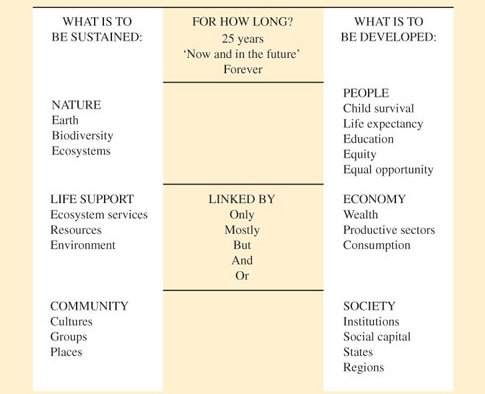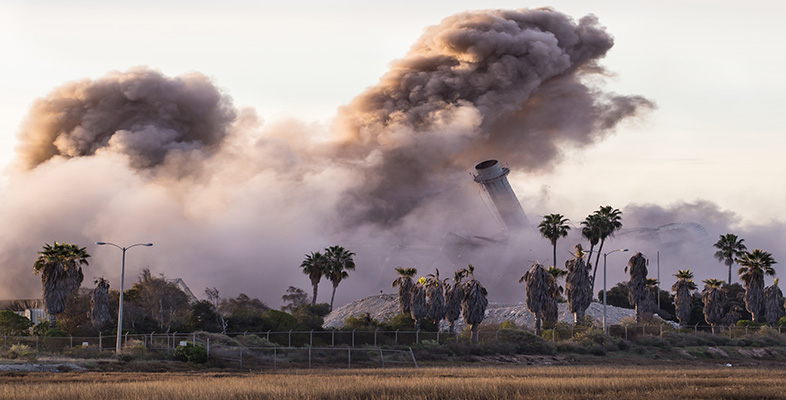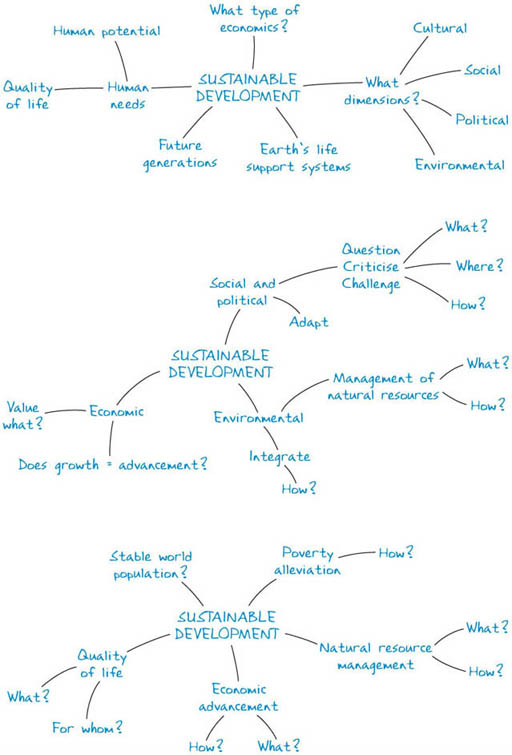2.5.2 Sustainable development
Several events in the 1970s and 1980s emphasised the global nature of environmental issues and the links between environment and development, which in turn led to the emergence of the concept of sustainable development. These events included:
- the production of the World Conservation Strategy in 1980 (by the International Union for the Conservation of Nature (IUCN), the World Wide Fund for Nature (WWF) and the United Nations Environment Programme (UNEP);
- the Brandt Commission on North/South relationships, chaired by the former West German Chancellor Willy Brandt, which reported in 1983;
- the World Commission on Environment and Development (WCED), which produced the report ‘Our Common Future’ in 1987 – also known as the Brundtland Commission, after Gro Harlem Brundtland, the then Prime Minister of Norway, who chaired the Commission. The Brundtland definition of sustainable development became particularly well known:
Sustainable development is development that meets the needs of the present without compromising the ability of future generations to meet their own needs.
This definition embraces at least three concepts that can be interpreted differently by different individuals: those of development, needs and intergenerational equity.
There have been many more definitions of sustainable development suggested since 1987. Figure 5 is a diagrammatic representation of one that came from the US National Research Council, Policy Division in 1999 (reproduced in Kates et al., 2005).

The ‘linked by’ section in Figure 5 refers to the different emphases in combining what is to be sustained with what is to be developed ranging from ‘sustain only’ or ‘develop mostly’ to combinations of what is to be sustained and developed using words such as but, and/or.
Activity 7 Concepts associated with sustainable development
List all the concepts included in the definitions of sustainable development given in this section so far, including Figure 5 (by concepts I mean ideas or notions, usually captured by key words or phrases, e.g. ‘development’ or ‘life expectancy’).
Discussion
The Brundtland definition incorporates the concepts of development, needs and intergenerational equity. The US National Research Council definition includes concepts of nature (earth, biodiversity and ecosystems), life support (ecosystem services, resources and environment), community (cultures, groups and places), people (child survival, life expectancy, education, equity, equal opportunity), economy (wealth, productive sectors, consumption) and society (institutions, social capital, status, regions).
However it is defined, sustainable development is a concept that has been in use since the mid 1980s and is still very much in evidence. Many people have at least partially accepted it, as was shown by the work done before, during and after the United Nations Conference on Environment and Development (UNCED) – the Earth Summit – in Rio de Janeiro in 1992 and the 2002 World Summit on Sustainable Development (WSSD) in Johannesburg. (Both of these initiatives will be discussed later in this section.)
Does it matter that the concept of sustainable development is open to interpretation? Is it important that people share an understanding of this concept or is it more a question of how people use it? Some people consider sustainable development to be a rather vague ideal with implications we have yet to understand, while others have used it to develop clear plans of action with achievable goals.
Here is one view from Sir Martin Holdgate when he addressed the UK Royal Society of Arts in 1995 in his role as President of the Zoological Society:
My conclusion is that the concept of ‘sustainable development’ is less novel than has often been made out. It is, in fact, a synonym for ‘rational development’, because it is a process of making the best practicable use of natural resources for the welfare of people. Its goal must include economic advancement, and there seems no fundamental reason why market economic systems cannot be adapted to generate sound growth while conserving our environment. But the goal of sustainable development is to deliver quality of life, and here we must pause. For there are indefinable qualities in the world that are not easily susceptible to economic valuation, and can easily be swept aside by the tide of expediency. Yet the richness and beauty of nature and the wonder of great landscapes can fill the dullest mind with awe. The development process must value these things, too, and it will indeed be a test of success if a century from now a stable world human population enjoys a quality of life far better than today’ s average, in a world with something near today’ s diversity of plant and animal species. It can be done. It will not be easy. The slower we are in adapting the more costly and difficult it will be.
Here is another view from Wendy Harcourt from her book Feminist Perspectives on Sustainable Development:
Development = economic growth is at the centre of development discourse. Even though many commentators point out that development is far more than economic growth but extends to social, political, cultural, environmental and gender concerns, economic growth remains firmly entrenched as the stated goal of development from which modern critiques of development begin.
Over the last few years, this approach to development had been criticised and challenged by a number of development economists interested in revising economic theory and methodology to include environmental considerations. They have been joined by development professionals concerned that poverty alleviation and the basic needs approach of development programmes are not bringing about the hoped-for end to mass poverty and environmental deterioration. Women working in development are also part of this debate in their argument that the fundamental gender bias of development thinking and practice prevents gender equity and ignores women’ s contribution to the economy and their role in the management of the environment. And radicals in both industrialised and developing countries enter into the debate questioning the whole modernisation process and Western knowledge systems on which development is based.
These thinkers and activists have found their voices in the recent policy debates on environment and development labelled ‘sustainable development’. They have used the political platform created by the United Nations Conference on Environment and Development (UNCED)... to bring their particular concerns about the thesis that development = economic growth to the public arena.
Activity 8 What does sustainable development mean?
- (a) Read the two quotes from Sir Martin Holdgate and Wendy Harcourt. Make a list of the words or phrases that strike you as particularly relevant to the concept of sustainable development. (You could begin with your answer to Activity 7 if you find it difficult to start this activity.)
- (b) Look at your list and try to group similar or related words together. Write alongside them what train of thought you were following. (Do not try to use all the words.)
- (c) Write a couple of sentences about your own perspective in relation to Holdgate’s and Harcourt’s. Do you identify with any of the points they have made through your own experience?
Discussion
- (a) sustainable development; rational development; natural resources; welfare of people; economic advancement; market economic systems; sound growth; conserving our environment; quality of life; indefinable qualities; world; economic valuation; expediency; richness and beauty of nature; wonder of great landscapes; development process; test of success; stable world human population; diversity of plants and animal species; it can be done; won’t be easy; adapting; costly; difficult; economic growth; development discourse; social, political, cultural, environmental and gender concerns; critiques of development; criticised and challenged; include environmental considerations; development professionals; poverty alleviation; mass poverty; environmental deterioration; gender bias of development thinking and practice; management of the environment; questioning the whole modernisation process and Western knowledge systems on which development is based; thinkers and activists have found their voices; political platform created UNCED; bring their concerns to the public arena.
(b) My train of thought – economic?
Economic advancement; market economic systems; economic valuation; costly; economic growth.
My train of thought – what adjectives?
Rational; sound; indefinable; world; economic; development; value; stable; costly; difficult; social, political, cultural, environmental; mass; whole; Western; public.
My train of thought – how?
Economic advancement; sound growth; expediency; value; it can be done; won’t be easy; adapting; critiques of development; criticised and challenged; include environmental considerations; poverty alleviation; management of the environment; questioning the whole modernisation process and Western knowledge; bring their concerns to the public arena.
- (c) One gap I noticed was that the perspectives of young people seem to be missing, although the Agenda 21 process and those that succeeded it did include ‘youth’ as a major group. There is also something about quoting from articulate people who have written their contributions, or had their words written down and reported, that makes me wonder whether there is a big gap in terms of the perspectives of the many people who do not communicate much in text, or who have never heard of the concept of sustainable development but still might make points for and against it if they had the chance. Perhaps some of the issues that might be of concern to them are here but how can I tell if I do not hear from them directly?
Activity 9 Raising questions about sustainable development
Now use your answers to Activity 7 and Activity 8 to focus on those aspects of sustainable development that raise questions for you so that you can pursue them later on. Use one or more spray diagrams to help you clarify, organise and develop your thinking. If you have not used spray diagrams before, first read through Box 1 and then follow the guidelines in the PDF below.
View document [Tip: hold Ctrl and click a link to open it in a new tab. (Hide tip)]
Discussion
Box 1 Why use diagrams?
Diagrams have already been used in this unit but this is the first time we are asking you to draw your own, which is why this box appears here.
Diagrams can help you to clarify, organise and develop your thinking and to explain to others how you are thinking. They also enable you to represent simultaneous processes or ideas, in a way that is very dif. cult in sequential prose. They can be used to help simplify and summarise a complex situation, which has the advantage that it can make it easier for others to understand and the disadvantage that in selecting what you include and leave out you oversimplify a situation, which can mislead.
One point to note is that the process of diagramming is often more important than the product. Think carefully about the purpose of your diagram. If it is to be used to communicate your thoughts to other people, you may need to show them the stages you have gone through, not just the final product. Where you have included opinions and judgements for your own purposes, you may need to prepare an edited version before you show it to others. You will also find it helpful to give a meaningful title to your diagrams. You will use diagrams in this course in two ways: firstly by drawing your own; secondly by interpreting those drawn by others. These are two separate but linked skills. Critical consideration of the nature of a diagram drawn by someone else can help to develop your own diagramming. There are many different types of diagram and many different ways in which they can be used. More will be said about these in later books.

